A STUDY OF AWARENESS ABOUT POCSO ACT, 2012 AMONG SECONDARY SCHOOL STUDENTS
- Stambh Organization
- Mar 16, 2022
- 12 min read
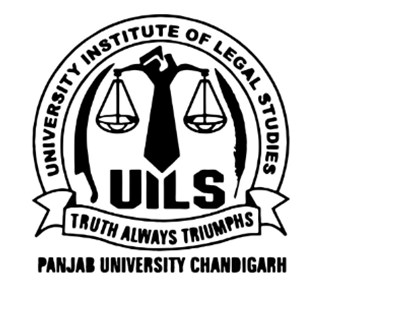
A STUDY OF AWARENESS ABOUT POCSO ACT, 2012 AMONG SECONDARY SCHOOL STUDENTS ABSTRACT: Present study is conducted to assess the level of awareness about POCSO Act among secondary school students. Researcher has developed a questionnaire of 10 multiple choice questions based on the POCSO Act,2012&252 students of class 10th& 12th from CBSE & PSEB schools were asked to fill the same through Google forms. The results revealed that students have slightly above average level of awareness i.e. 6.31 out of 10. Students are having almost same level of awareness with respect to their gender, class grade and locality but the children, whose mothers are working, exhibit higher level of awareness regarding the POCSO Act& Child Sexual Abuse.
KEY WORDS: POCSO ACT 2012, Awareness, Secondary school students INTRODUCTION: The Protection of Children from Sexual Offences (POCSO) Act was brought into practice in 2012. It is a unique law to ensure protection of children against sexual offences. This legislation has been born out of the need to deal with the increasing sexual abuse against children in form of abuses like rape, pornography, various forms of penetration and criminalizes acts of immodesty against children too. Sexual abuse on children is a stigma in the society as it shakes the human conscience at large & hampers healthy life of children. Such an act of abuse bears severe physical &psychological effects on the victim child; he can never have a normal growth. In such cases not only the body bears injuries but the mind is the worst affected. PRIMARY FEATURES OF POCSO ACT, 2012 are: · The preamble of the Act states that this Act was enacted to protect children from sexual assault, sexual harassment, pornography etc. · The Act comprises of 46 sections. · The chief important matter of this Act is the best interest of children. The Act aims to help in healthy physical, mental, and social development of child. · The Act is gender neutral and at the same time covers all the aspects that only specified group of gender could probably face. · The Section 2(d) of the Act defines child as any person below the age of 18 years. · It also defines all the central terms like sexual assault, child pornography, penetrative sexual assault, etc. · The Act also deals with the matter of child pornography and circulation and possession of e-content of such activities as well. · The Act provides for child-friendly procedures of reporting and investigation. The psychological condition of the abused child is given prime consideration at every step. · AlakhAlokSrivastava v. Union of India 1 May 2018[1] A Public Interest Litigation was filed by advocate Alakh Alok Srivastava highlighting non-compliance by the States with provisions of the POCSO Act. A 3 judge bench headed by the then Chief Justice Deepak Mishra, Justice D. Y. Chandrachud and Justice A.M. Khanwilkar issued guidelines for the speedy disposal of cases under the POCSO Act and also orders to the States regarding the same. A REVIEW OF RELATED LITERATURE: · The Protection Of Children from Sexual Offences Act, 2012 [Act 32 of 2012]:It is an Act intended to protect children from offences of sexual assault, harassment and pornography which also provides for establishment of Special Courts for trial of such offences and for matters connected with them. · Krishnakumar P., Satheesan K., Geeta MG, Sureshkumar K. (2014) conducted a study on Prevalence and spectrum of sexual abuse among adolescents in Kerala, South India and reported that 36 per cent boys and 35 per cent girls had experienced sexual abuse in life. · Seth and Srivastava(2017) conducted a study on the Child Sexual Abuse: Management and prevention, and protection of children from Sexual Offences (POCSO) Act and found that abused children & their families most often contact Pediatricians and allied medical professional before approaching any other authority. They have an important role in finding out Child Sexual Abuse, providing medical care and support to the victims and their families. · Mathew (2017) in his research “The Legislative models of prosecuting child sexual abuse in India: a review and critical analysis” attempted to show how substantive provisions of the Indian criminal law on child sexual abuse ought to be interpreted and where the law needs to be changed. The findings in his work encouraged further legal research into the nature and effects of child sexual abuse as seen in Indian judicial decisions, as well as studies of sentencing trends in child sexual abuse cases in India. · Bhosale M., Carvalho C., Shaikh N. (2018) conducted a study to explore the level of awareness of MBBS students regarding awareness about various practical aspects of Child Sexual Abuse (CSA) among MBBS students in context of POCSO Act, 2012. 586 MBBS students studying in a Government Medical College in Maharashtra, India were given a self-prepared questionnaire totest various aspects of CSA from signs and symptoms, physical and psychological impact, treatment, to legal remedies available in context of the POCSO Act, 2012. There were 277 males and 309 females between 18 to 25 years of age who appeared in the test. The scores were recorded and results were analyzed. Results revealed that 90 % of the students had scores <5, meaning there is lack of awareness about CSA even among MBBS students. · Sony Singh (2018) in his study “Juvenile Justice and Protection of Children from Sexual Offences (POCSO) act, 2012-a socio-legal analysis of existing laws and practices” and concluded that Exposure to violence at an early age can impair brain development and is associated with a range of health problems. It can lead to acute and long-term problems for children‘s physical, sexual and reproductive health as well as their psychological well-being. The researcher has tried to interpret the existing laws harmoniously so that Primary consideration should be given to the best interests of the child in all actions concerning the child undertaken byany Public or Private body concerned. · Renu, Geeta Chopra (2019) undertook a study on Child Sexual Abuse in India and the Protection of Children from Sexual Offences (POCSO) Act 2012: A Research Review, by the medium of this study the researchers analyzed the implementation of POCSO Act in India and highlighted various difficulties in doing the same. The paper also presents the researches done on POCSO putting across issues related to mandatory reporting, consensual sex, doctor’s preparedness for handling child sexual abuse cases, and status of special courts under POCSO. · The Hindu (2021): A recent article by The Hindu states that the Supreme Court has decided to examine whether POCSO Act could be employed to punish teenagers for “consensual” physical relationships which later turn bitter or not. A Bench led by Justice Indira Banerjee decided the case of a man accused of rape of a 17 year old girl while he was 18 years old. They had a “relationship” while they were school mates. However, he refused to marry her & a complaint was filed against him regarding the same. The trial court found the man guilty and sentenced him to 10 years’ imprisonment under the POCSO Act, 2012 despite the fact that the girl during the trial admitted in court their relationship was consensual. SIGNIFICANCE OF THE STUDY The rate of sexual offences against children is increasing alarmingly all over the globe. India ranks 5th all over the worldin terms of rate of sexual offences committed against children. Yet, laws & procedures in India are inadequate to deal with such a sensitive and serious issue. The Law Commission in its 172ndreport has reviewed complete law dealing with sexual offences after Sakshi v UOI case. The Commission suggested various amendments to the laws dealing with this subject. The Protection of Children from Sexual Offences (POCSO) Act, which came into force November 14, 2012, is the first comprehensive law in India dealing specifically with sexual abuse of children. Despite various progressive steps being taken, children suffer from Sexual offences at various arenas of life and at different ages. It is often seen that school going children lack awareness about sexual abuse and its prevention (POCSO Act, 2012). The study tries to accentuate the irregularities in the implementation of the concerned legislation and advocates awareness about sexual offences and POCSO Act 2012 among the secondary school children and also recommends certain pertinent points to stop the sexual offences against children. OBJECTIVES OF THE STUDY 1. To explore the level of awareness about sexual abuse & its prevention among secondary school students. 2. To analyze the different levels of awareness about POCSO Act, 2012 among secondary school students in relation to gender, locality, class grade and occupation of mother.
SAMPLE AND DATA COLLECTION In the present study students studying in 10th and 12th classes were taken as sample units. 252 students were selected randomly from CBSE & PBSE. Researcher has developed a questionnaire by her-self. Students were asked to fill this questionnaire including 10 multiple choice questions through Google form, based on the knowledge of POCSO Act. The questions were as follows; 1. What is meant by ‘Child Sexual Abuse’? a. Rape with a minor. b. Use of abusive words in the presence of a minor. c. Any form of abusive sexual behavior with a minor. d. None of the above 2. The POCSO Act stands for: a. Prevention of child related social offences Act b. Prevention of rape & other sexual offences against children Act c. Prevention of children from sexual offences Act d. None of the above 3. The POCSO Act was enacted in: a. 2019 b. 2009 c. 2011 d. 2012 4. Who is a “Child” under section 2 of the POCSO Act a. Any unmarried person b. A person below the age of 18 years c. A person below the age of 15 years d. Any person who goes to school as a student. 5. What is the punishment of Sexual Assault under the POCSO Act a. Either imprisonment of 5 years or fine of rs.50,000 b. Imprisonment not less than 5 years & may extend to 10 years and also liable to fine of rs 10,000 c. Life imprisonment & fine d. Imprisonment not less than 3 years & may extend to 5 years & also liable to fine 6. The POCSO Act vests which authorities with the responsibility to create public awareness about the provisions of the Act : a. State legislatures & Local Governments b. School authorities c. The Central Government & the State Government d. All the above 7. According to s. 41 the provisions of POCSO with regard to sexual abuse of a child are not applicable in which of the following case: a. In case of consensual sexual activity among minors b. In case of medical examination/ treatment done with consent of the parents c. In case of sexual activity undertaken with the consent of the parents d. In case of child marriage 8. Which of the statement is true about the POCSO Act a. The POCSO Act is gender neutral b. The POCSO Act deals only with penetrative sexual offences c. Only IPC sections are added in FIR & not POCSO. d. POCSO lays special emphasis on female minors 9. Any person who apprehends any offence under the POCSO Act has been or is to be committed shall report to a. Special Courts b. Media c. Local Government d. Special Juvenile police or Local police 10. Which of the following deals with Child Sexual Abuse : a. Juvenile Justice (care & protection of children) Act, 2015 b. Goa Children’s Act, 2003 c. I.P.C. Section 354 d. None of the above,
e. only POCSO
ANALYSIS
Data has been collected from the target sample units through Google form, then it was tabulated under different headings in accordance to the objectives, like male/female, urban/rural area, 10th/12th grade, and occupation of the mother. The data was then analyzed by using descriptive analysis on MS-Excel. Mean score (average) and percentage was calculated and on the basis of interpretation of resulted have been made. The analysis and interpretation is as follows;
Table-1 Showing percentage of correct responses given by students

Figure-1 Graphical presentation of percentage of correct responses given by students
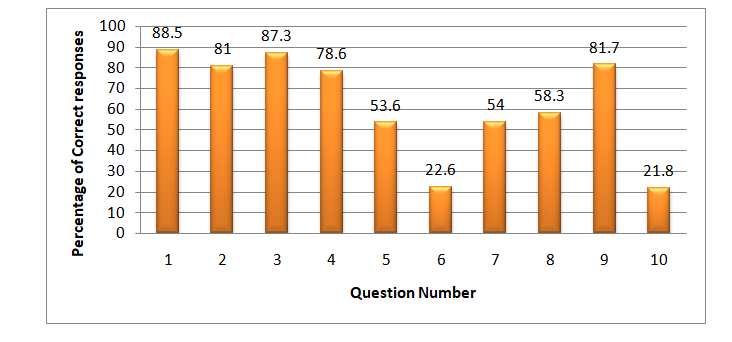
The Table 1 shows correct responses to each question & Figure 1 is the graphical representation of the same.
· The 1st question was correctly answered by the highest number of students. So we infer that students have general awareness on what is child sexual abuse.
· The 2nd, 3rd& 9th questions which were related to the POCSO Act were also answered correctly by a high number of students. So we assume that students have basic knowledge about the POCSO Act.
· The 4th question was the definition of a child under the POCSO Act, 2012, though it is a question particular to the POCSO Act but the answer corresponds with the definition of a minor in most of the Indian legislations but was answered correctly by 78.6% of students which implies that 21.4% of students are not even able to choose the most relevant option out of the others.
· The percentile of students answering 5th&7th questions correctly was 53.6%, 54%, respectively. These questions concerned particular provisions of the POCSO Act, 2012 .So we discern that despite the efforts of the central & state governments & school boards to create awareness about the provisions of POCSO among the school students, the detailed provisions of the Act have not yet been indoctrinated among the students.
· The question number 6 received as low as 22.6% of correct responses which was about the authorities vested with the responsibility to create public awareness on the provisions of the Act. Thus, it is revealed that the students lack detailed knowledge about the provisions of the POCSO Act, 2012.
· The 8th question has been answered by 58.3% students correctly. The students were supposed to choose one correct statement of the given options which were general statements about the POCSO Act, 2012 but 41.7 % students could not answer correctly that POCSO is gender neutral legislation.
· The question number 10 received the lowest number of correct responses (21.8%). This shows that students lack awareness on the Goa Children Act, 2003 which was the only specific child abuse legislation before the 2012 Act.
Table-2 Difference of awareness level among Female and Male students

Group Mean score of correct responsesFemale6.31Male6.19
Figure-2 Graphical presentation of different awareness level among Female and Male students
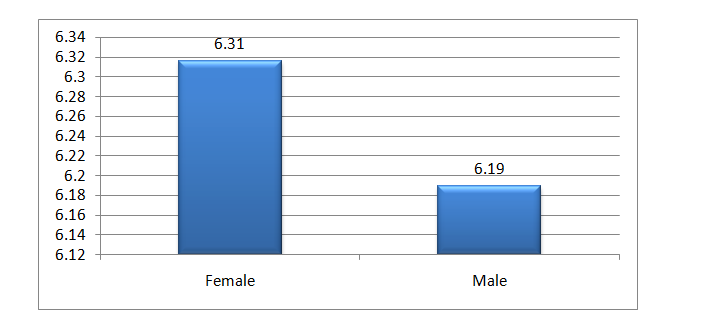
Table-2 is showing the mean score of correct responses given by the male and female students on the given 10 questions. It is evident through the table that female students have 6.31 mean score and male students have 6.19 mean score out of 10. It further implies that averagely male and female students have almost same level of awareness of POCSO Act. So by this we can say that the basic assumption the POCSO Act that, “it is not gender specific and male and female students must have the awareness of it”, is fulfilled as not much difference is found in the awareness level of them.
Table 3: Difference of awareness level among students from Rural and Urban areas
GroupMean score of correct responsesRural6.31Urban6.19
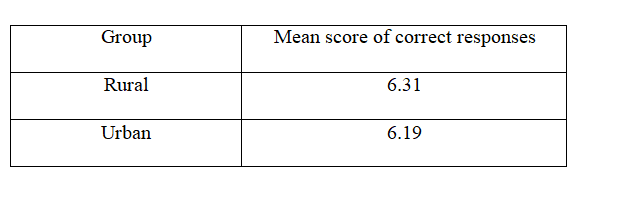
Figure3: Difference of awareness level among students from Rural and Urban areas
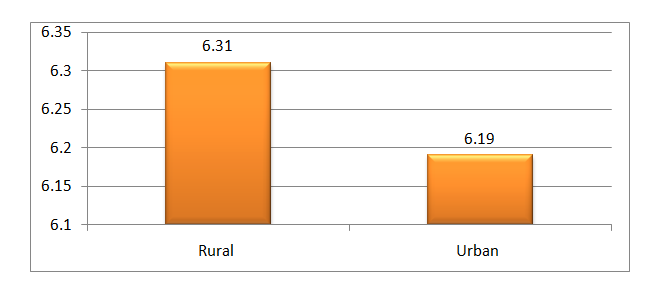
TABLE -3 shows that mean score achieved by students of rural & urban areas is 6.31 and 6.19 respectively. They possess almost the same level of awareness with a difference of 0.12% which is a negligible difference. It can be further implies that students from rural and urban areas are having same awareness level and rural area students have a bit high level of awareness of POCSO Act, it may be due to the reason that they are travelling form villages to cities in public transportations for attending schools, coaching centers, ILETS etc. so by this exposure they are driven to be aware of POCSO Act.
Table 4: Difference of awareness level among 10th class students and 12th class students
GroupMean score of correct responses10th class students6.2312th class students6.42

Figure 4: Difference of awareness level among 10th class students and 12th class students
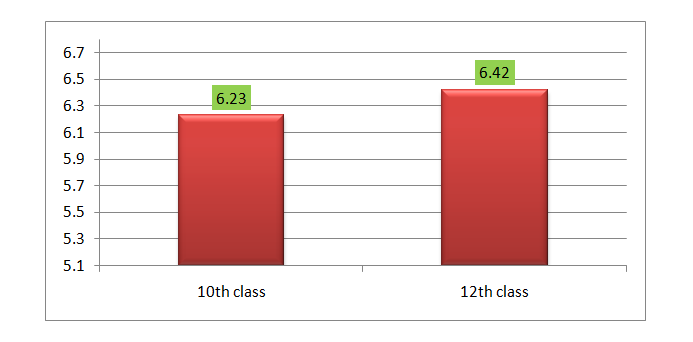
It is evident from the Table-4 that negligible difference of 0.19% is there between the students of class 10 & 12. It shows that students are fed with basic knowledge about POCSO with their entrance to the school at primary stages so when they grow up to the level of 10th& 12ththere awareness is almost at the same level.
Table-5: Difference of awareness level among students with relation to occupation of their mother
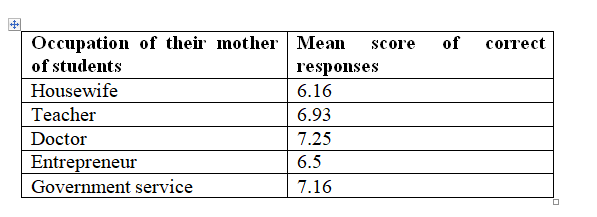
Occupation of their mother of studentsMean score of correct responsesHousewife6.16Teacher6.93Doctor7.25Entrepreneur6.5Government service7.16
Figure-5 Difference of awareness level among students with relation to occupation of their mother
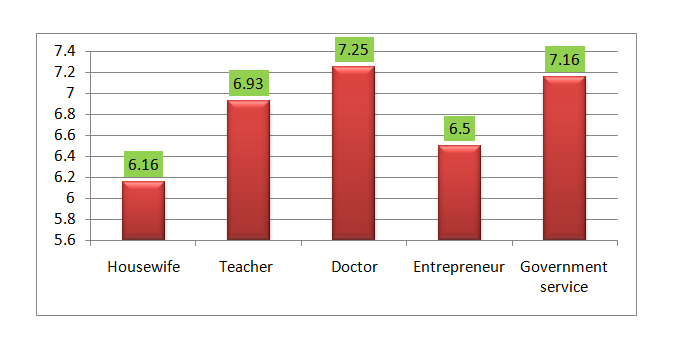
Table-5 is revealing the level of awareness of students in relation to the occupation of their mothers. It is evident that the children of housewives and entrepreneur mothers are having the lowest level of awareness regarding sexual abuse offences; it may be due to lack of exposure towards the continuous educational process and current circumstances too. The children of mothers who are working as teachers, doctors and other governmental offices have high level of awareness. It may be due to regular acquaintance with the current affairs, participation in seminars/workshops etc.
Appropriate awareness campaign on social media and television is recommended so that the housewives and entrepreneur mothers could raise their awareness level regarding the POCSO Act. Schools must come forward to so the same in the form of seminars, workshops, interaction seminars/sessions for the mothers to raise their level up to a remarkable one.
CONCLUSION
The awareness of POCSO Act is crucial for the students, parents and overall society. The authorities are working for this but the appropriate awareness among students is not satisfactory as the study shows that students have slightly above average level of awareness i.e. 6.31 out of 10. Students are having almost same level of awareness with respect to their gender, class grade and locality. But when we are talking about the upbringing of child in the families where their mothers are working in government and private sector children exhibit higher level of awareness regarding POCSO Act.
So it can be concluded that government and other authorities like NGOs they must do some intense efforts to spread the awareness of it while utilizing multi-media and especially social media, so that the outreach of the benefits of this Act must be there with the last citizen.
-:References:-
Krishnakumar P, Satheesan K, Geeta MG, Sureshkumar K. (2014 ). Prevalence and spectrum of sexual abuse among adolescents in Kerala, South India.Indian J Pediatr. 81(8):770-4. doi: 10.1007/s12098-013-1260-z. Epub 2013 Oct 25. PMID: 24154965.
Mathew, LinaAcca (2017). Legislative models of prosecuting child sexual abuse in India: A review and critical analysis.Ph. D. thesis, Queensland University of Technology.DOI: 10.5204/thesis.eprints.107784
MinakshiBhosale, Caryn Carvalho, NazrahShaikh (2018). Child Sexual Abuse: Level of Awareness among Medical Students in context of the POCSO Act. Journal of Medical Science and Clinical Research6(9), 400-406.
Renu, R., & Chopra, G. (2019). Child Sexual Abuse in India and the Protection of Children from Sexual Offences (POCSO) Act 2012: A Research Review. Integrated Journal of Social Sciences, 6(2), 49-56.
Seth, R., Srivastava, R.N. (2017) Child Sexual Abuse: Management and prevention, and protection of children from Sexual Offences (POCSO) Act.Indian Pediatr54,949–953. https://doi.org/10.1007/s13312-017-1189-9
Sony Singh (2018). Juvenile justice and protection of children from sexual offences POSCO act 2012 a socio legal analysis of existing laws and practices. Ph.D. Thesis, University of Lucknow.http://hdl.handle.net/10603/214283.
V.S &Chavan.R.L (2019). Child Abuse and Neglect: Gender Based Teachers Awareness. International Journal of Indian Psychology, 7(3), 113-121.
[1]WRIT PETITION (C) No. 76 of 2018
About The Author
Vanshika Joshi
research intern ,
The Stambh Organization ,India
Student,
B.A LL.B (Hons.), 4th Semester, University Institute Of Legal Studies, Sector 14
Panjab University, Chandigarh.
Commentaires